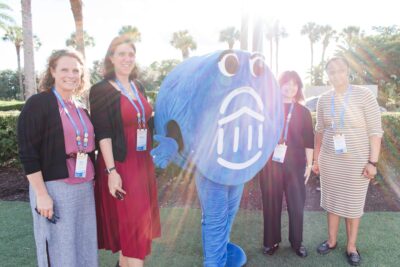Reimagining virtual employer engagement
As colleges and universities continue to gear up for the new academic year, career services leaders are grappling with how to connect students and employer partners in a virtual environment. To learn more about what virtual engagement will look like this fall, EAB hosted a webinar in late July 2020 with leaders in the career services and campus recruiting spaces to discuss the future of virtual employer engagement. During the session, Kevin Monahan, Senior Associate Dean for Career and Professional Development at Carnegie Mellon University; Kelvin Rutledge, Director of the Office of Career and Professional Development at Southern Connecticut State University; and Jennifer Tracy, Vice President of Recruiting Solutions at Spectrum shared lessons learned from this past spring and summer and plans for this fall and beyond.
Learn More with EAB’s Virtual Employer Engagement Playbook
Innovate and rethink your employer engagement offerings in the virtual environment.
Employers and career services leaders alike agree that even after the COVID-19 pandemic subsides, campus recruiting and other employer engagement opportunities are unlikely to revert to their pre-pandemic, mostly in-person state. Kevin Monahan told participants that he is “not confident that we will go back to normal. This is an opportunity for us to think and act differently if we can take the leap. These companies will get their hires without coming to campus and doing traditional practices, and then what will be impetus to get companies to come back?”
Jennifer Tracy highlighted new ways Spectrum is connecting with students in the virtual environment. This past spring, Spectrum judged virtual case competitions at partner institutions to engage students through their academic curriculum. Over the summer, Spectrum engaged students interning virtually through an executive speaker series, a virtual scavenger hunt, and a virtual community service activity.
Career services offices must consider the pain points caused by COVID-19 for students and employer partners. For example, students missed out on valuable professional experience due to internship reductions and cancellations. For employers, they missed the opportunity to brand themselves with students, build relationships, and preview potential talent. This “lost summer” provides an opening for career services to innovate and address the missed opportunities for both employers and students. When considering how to address these pain points, Kelvin Rutledge advised career services offices to be thoughtful about their approach to employer and student programming as many students are navigating a proliferation of virtual programming and increased personal burdens due to COVID-19.
Offer virtual engagement opportunities focused on a single skill to connect students and employers in a small, targeted setting.
To address the gap in student and employer connection this past summer, the career services offices at Carnegie Mellon University and Southern Connecticut State University created virtual employer sessions focused on skill building. These sessions allowed students to build skills, provided employers that weren’t previously a primary recruiter on campus to receive more attention from students, and helped foster connections between students and employers in a non-recruiting environment. Jennifer Tracy affirmed that skill building opportunities are a great way to engage employers that are new to the institution.
Virtual employer sessions should address one skill such as design thinking or what it means to network virtually during COVID-19. Targeted, skills-based sessions provide students with tangible, career-oriented information and helps facilitate further conversations with employers. While students cannot fully master a skill or topic in one short session, students can follow up with employer presenters with specific questions. Kevin Monahan noted that employer panel presentations on skills-based topics this past summer led to more robust conversations than prior networking opportunities for students at Carnegie Mellon University. Additionally, a shared experience with the employer presenters makes students less hesitant to follow up with the employer.
Proactively address new equity and accessibility barriers students are experiencing in virtual career services and employer engagement activities.
The virtual environment poses challenges for many students with technology, time commitment, and geographic constraints. Students without access to technology or Internet broadband struggle to take full advantage of virtual offerings. Similarly, students with work or personal commitments during the day, or students who live in a different time zone may be unable to participate in a virtual event during the scheduled time. To help address these challenges, the career services office at Carnegie Mellon University records as many events as possible and posts them on their website so students can access the information at a time convenient for them.
To address accessibility challenges at Southern Connecticut State University, Kelvin Rutledge said the career services office created a three-part strategy informed by the following questions:
- Where can the career services office refer students for additional resources and support (e.g., loaner laptops)?
- How is the career services office ensuring that there is space for students to engage in competencies? How can the career services offices provide a differentiated model of support to reach all students?
- How can the career services office engage in more campus-partnership collaborations? For example, how does the career services office and the university more widely navigate virtual discrimination?
Innovating practices, building student skills through focused non-recruiting activities, and addressing equity and accessibility barriers for students and employers all represent imperatives for career services leaders in the virtual environment.
More Blogs

Three lessons from 1,200 student success leaders on higher ed’s future

5 higher ed thought leaders we are following
